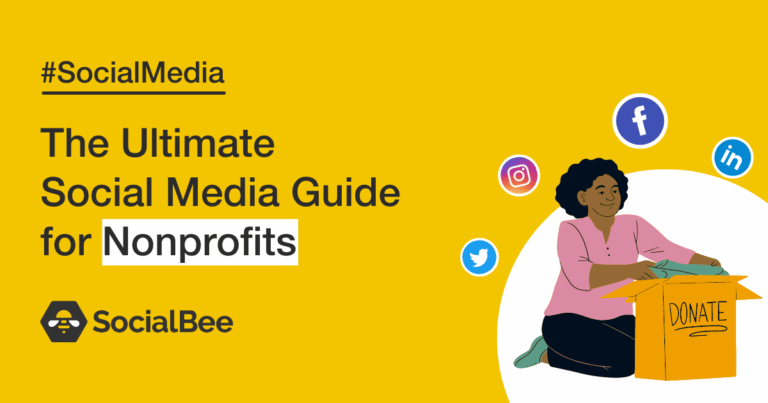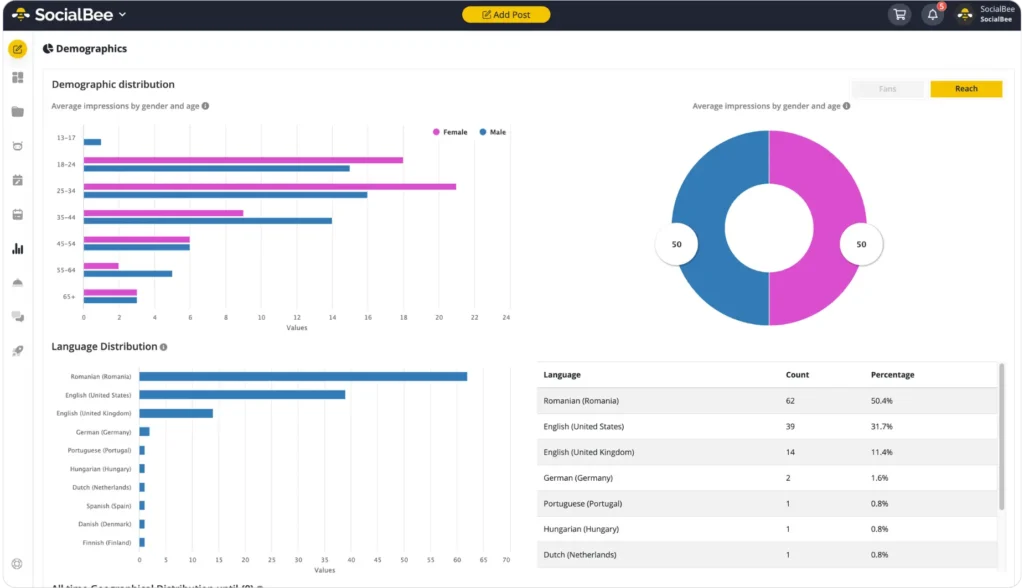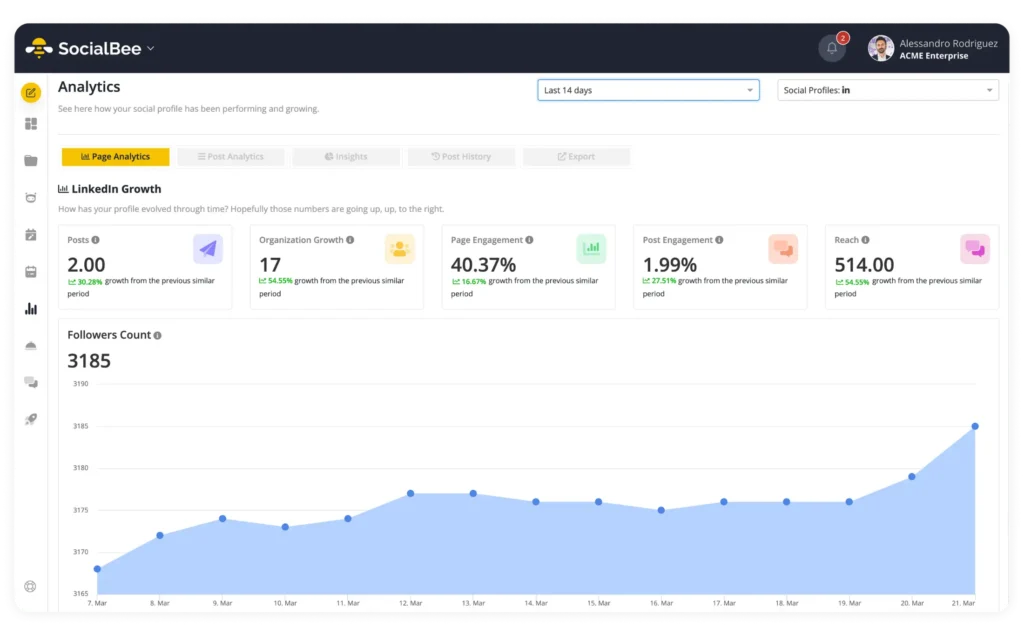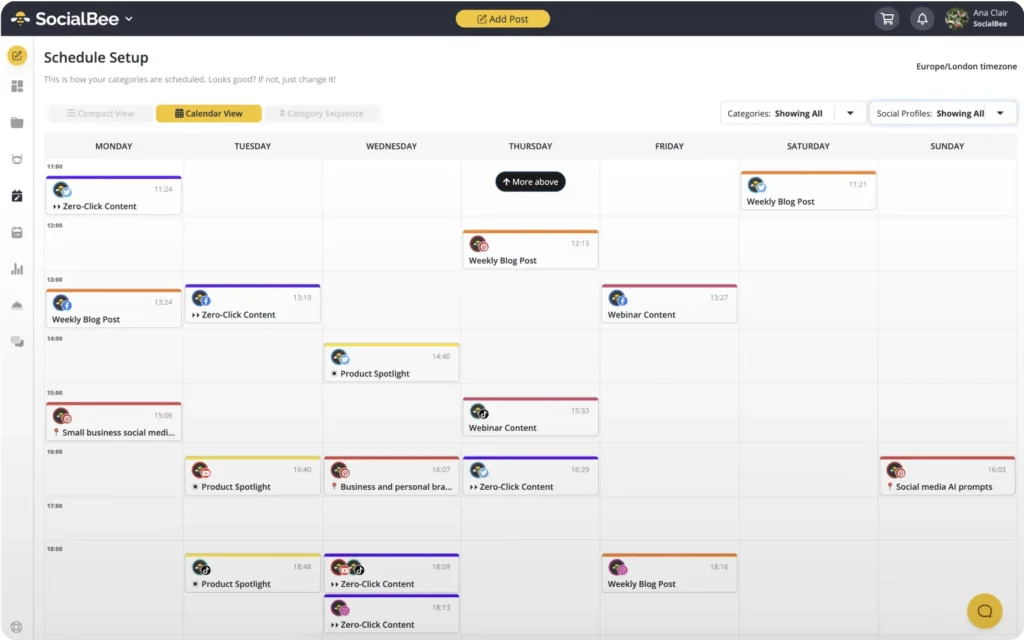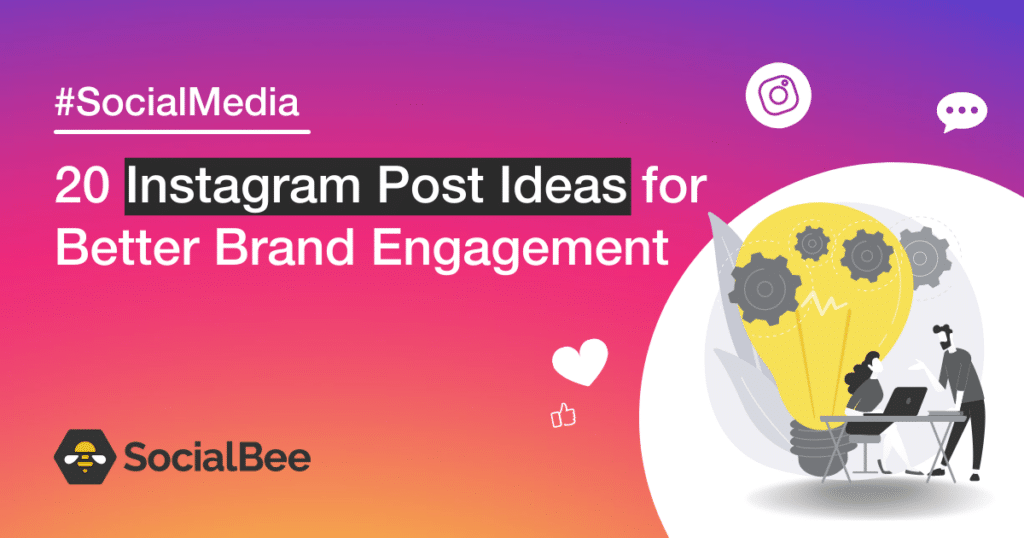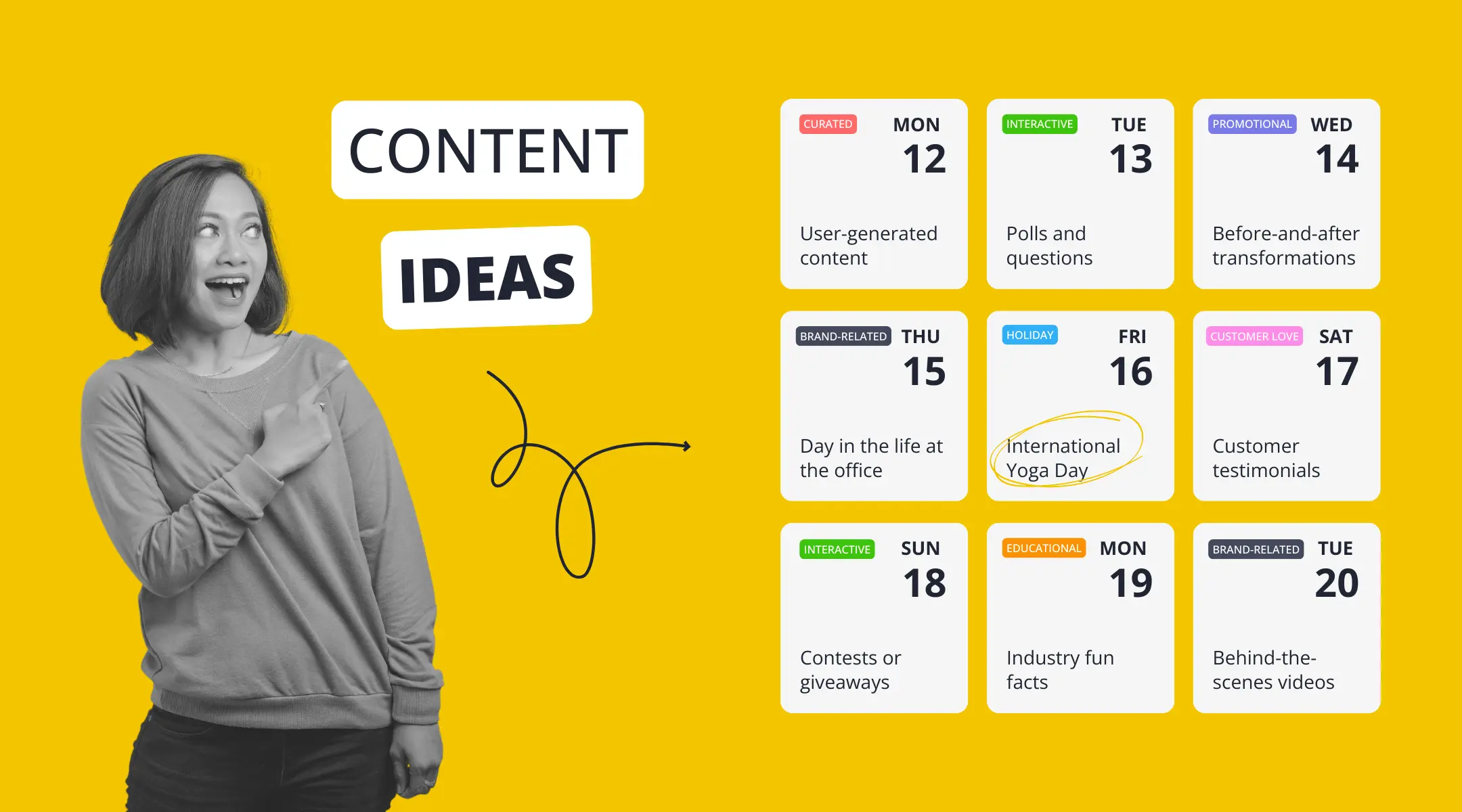
Content Writer
If you’re looking for clever ways to do social media for nonprofits, you came to the right place.
As you might know by now, there are plenty of benefits when it comes to leveraging the power of social media to promote your organization’s mission. More exactly, it can help you familiarize people with your cause, promote your next fundraising events, and build relationships with other organizations and business professionals.
If you’re not sure about how to get started, this guide will provide you with everything you need to know about social media for nonprofits. We’ll cover the benefits of social media and share some tips for creating a social media strategy. Also, we’ll detail the best practices for creating top-performing content.

Do You Run a Nonprofit?
Use code DOGOOD50 at checkout and get a 50% discount on all SocialBee tool plans.
The Benefits of Social Media Marketing for Nonprofits
To start, we’re going to take a look at how a nonprofit social media strategy can empower your organization.
Here are the top three benefits of social media marketing for nonprofits:
- Raise awareness
- Build communities
- Inspire action
1. Raise Awareness
Raising awareness is one of the most important social media strategies that a nonprofit can use. It can attract new donors and volunteers. Naturally, social media is one of the best ways to achieve these goals.
There are many social media platforms that a nonprofit can use to increase awareness about its noble cause. Each channel has its own strengths and weaknesses, and each should be used in a way that will reach your audience most effectively.
For example, your Facebook page should be reserved for sharing updates and information about your fundraising tools. It’s also beneficial to consider using fundraising email templates that are specifically designed for nonprofit organizations to streamline the process and ensure that your messaging is consistent and impactful. Instagram, on the other hand, should be reserved for sharing visual content, such as Instagram Stories, Reels, and carousels of photos and videos from your fundraising events and charitable activities.
2. Build Communities
There’s no doubt that social media has completely revolutionized the way we connect with others. It’s made it easier for creators and businesses to connect with people all over the world and share information in the blink of an eye.
For nonprofits, social media can also be a powerful tool for building a loyal community of supporters.
Here are some tips for how nonprofits can use social media to build a strong relationship with your followers:
- Post regularly and consistently – This nonprofit social media strategy should help you stay top-of-mind with your followers and keep them engaged with your organization.
- Be responsive – Whenever people take the time to reach out to you on social media, you should show your appreciation and offer a quick reply. This conveys that you value your followers’ opinions and feedback.
- Share inspiring stories – Don’t be afraid to showcase the impact of your work on social media. This is one of the best ways to engage potential supporters and inspire them to get involved with your cause.
- Create exclusive content – Offer your social media followers exclusive content that they can’t find anywhere else. This could be anything from behind-the-scenes photos to video content of your work in action. By giving them a sneak peek into what you do through visual content, they’ll feel more connected to your nonprofit and more likely to support your work.
3. Inspire Action
Social media can be a powerful tool when used to reach new donors and increase donations for nonprofits.
A social media campaign can be a great way to increase awareness for your cause, build relationships with potential donors, and ultimately increase donations.
Here are some tips for using social media to increase donations for your nonprofit:
- Tell your story – Post regular content that showcases the work your nonprofit is doing. Also, don’t forget to feature persuasive calls-to-action (CTA) in your posts’ descriptions, asking people to donate to your cause.
- Create a sense of urgency – Do your best to encourage people to make a donation. You can urge people to donate instantly by sharing stories that emphasize a sense of urgency about the people your nonprofit is helping.
- Build relationships – In order to increase donations, you should gift merchandise on special occasions or showcase donors on your website or social media channels. That way, your target audience will know that you care about their contributions and will be motivated to partake in your future fundraisers. You can also create a strong fundraising plan that outlines the strategies, tactics, and timelines for your fundraising activities. This plan should include unique fundraising ideas to diversify your income streams.
Follow these social media tips to increase donations for your nonprofit. With a little effort, you can reach new donors and change the world in a positive way.
How to Create a Nonprofit Social Media Strategy
Social media strategies are certain to help nonprofits become organized when it comes to their online presence.
It is possible for nonprofits to better engage with their audience, build relationships with key stakeholders, and achieve their overall communications goals by having a solid plan in place.
Here are four steps to creating a nonprofit social media strategy:
- Choose the best social media platforms for your nonprofit
- Define clear goals for your social media campaigns
- Understand your target audience
- Monitor your nonprofit’s social media presence and performance
1. Choose the Best Social Media Platforms for Your Nonprofit
The best social media sites for your specific nonprofit will vary, depending on your organization’s objectives and main audience.
However, there are many social media platforms that could be a perfect fit for nonprofits. All of the following platforms offer different features and benefits that can help nonprofit organizations surpass all expectations.
Here are the best social media platforms for your nonprofit:
Instagram is a platform that can be used by nonprofits who love spreading their message through engaging visuals. Ideally, it should be used to share photos and videos of the work that the nonprofit is doing via Instagram Stories, Reels, or feed posts.
In addition, Instagram can be used as a tool for raising donations for nonprofits.
Here are some ideas for engaging your Instagram followers:
- Ask followers to make a donation by tagging a friend in a post
- Ask followers to tap the link in bio or the one that can be found in Instagram Stories which leads to a donation page
- Ask followers to make a donation and enjoy special benefits
Unlike other social media platforms, with Twitter, NGOs can substantially increase donations from individuals who wish to make a positive difference in the world. This dynamic and ever-changing channel is perfect for monitoring the latest trends and being in the loop in regard to the latest industry news.
Here are three tips on how to do that:
- Optimize your Twitter account – Make sure that your account is easy to find and follow. Include a link to your website and make sure your profile features relevant contact information.
- Share news – Your followers appreciate finding updates about your organization and its valuable work. Also, make sure to share regular stories about the people you help. This could attract generous potential donors.
- Leverage analytics – Use Twitter monitoring and analytics tools to track how well your tweets are performing. Use this insight to adjust your marketing strategy accordingly.
LinkedIn is an ideal social media channel for nonprofits to use in order to professionally connect with prospective donors and promote their organization’s mission. By creating a LinkedIn profile for your nonprofit and optimizing it, you can make it easy for new donors to find out more about your organization and learn how to support it.
The main ways nonprofits can use LinkedIn is to find other compatible businesses and use outreach practices to convert them into sponsors or recruit volunteers. SocialBee’s LinkedIn Lead Generation service is an amazing way to
In addition, you can use LinkedIn to post regular updates about your organization’s work and showcase how donations are being put to use. This can help create a more engaged community of donors who feel connected to your nonprofit and its mission.
Facebook is one of the most frequented social media platforms and it can be a powerful tool for charities. 93% of NGOs have Facebook pages, so why not give them a try? Your marketing strategy will surely flourish once you choose to use this platform.
Here are some tips on how to use Facebook for charity:
- Optimize your page – Make sure you have a page for your charity and that it is up-to-date. Include information about your charity, such as what it does, who it helps, and how people can donate.
- Share news and updates – Share photos, Facebook Stories, and video content about the work your charity is doing. Also, educate people on how they can get involved.
- Start a Facebook fundraiser – You can set up a fundraising campaign on Facebook and ask people to donate to your charity. You should also add a Donate button to your page.
- Create a Facebook group – Bring your community of donors, volunteers, and supporters into one place by creating a Facebook group.
2. Define Clear Goals for Your Social Media Campaigns
Nonprofits can make use of a set of multiple opportunities when it comes to social media.
In contrast to businesses that focus on profitability, nonprofits can use social media to enhance their communications strategy and build relationships with donors, volunteers, and other stakeholders. In order to make the most of this opportunity, you’ll need to set some clear-cut goals.
Your goals should be SMART:
- Specific – Mention what you want to achieve and how you want to achieve it
- Measurable – Make sure that your goals are easy to measure with the help of analytics.
- Achievable – Decide on an attainable goal that is not removed from your NGOs mission
- Relevant – Focus on goals that are important and high-priority for your NGO
- Time-bound – Pick a specific time frame and see how you can achieve any specific goals
For example, you might want to increase the number of Twitter followers by 30% in the next six months. Alternatively, you might want to raise $3,000 from online donations in the next three months.
Once your goals are all set, it’s important to develop a plan of action that will help you achieve them. This plan should include strategies such as creating engaging content, using hashtags effectively, and targeting the right audience.
3. Understand Your Target Audience
Nonprofits always rely on the generous donations of individuals and organizations to sustain their work. In order to solicit donations, it is important to understand who your audience is and which social media channels they are using.
Research shows that 55% of people who engage with nonprofits on social media take action through donations, volunteering, and by attending charitable events. Also, the latest statistics reveal that online giving grew by 12.1%, which is awesome news for NGOs who wish to connect with their audience in the digital realm.
First, it’s important to research your target audience and identify the social media channels they are using. That way, you will have a higher chance of reaching them with your message.
Learn more about your target audience by leveraging demographic data about their age, country, and language distribution.
Start our 14-day free trial today!
With SocialBee, you can learn more about your followers by just taking a quick look at your demographics. Also, if you’re looking to further inform your content strategy, SocialBee helps you check your top 3 post types and therefore identify the content that resonates with your audience the most.
For example, if your audience is made up of young adults between the ages of 18-30, you may want to share more photos and videos that capture the excitement of your work. Also, if your audience is made up of older adults between the ages of 40-60+, you may want to focus on posts that provide factual information about your work or share stories about how your work has benefited people in the community.
Understanding what makes your social media audience tick can add value to your content strategy and therefore encourage them to donate to your organization.
4. Monitor Your Nonprofit’s Social Media Presence and Performance
As a nonprofit, it’s important to constantly monitor your online presence and performance. By doing so, you can easily see what’s working, what’s not, and how you can better adjust your efforts in order to meet your goals.
For this, you’ll have to use powerful social media analytics tools to track your audience growth, engagement levels, and which posts are most popular.
SocialBee is an all-in-one social media management tool that can help you monitor your presence and performance. Among many other things, you can track your engagement, keep an eye on your demographics, and pay attention to the top 3 post types and categories that your followers prefer.
Monitor your social media presence and performance across all channels and generate insightful PDF reports in a matter of seconds.

Leverage the Power of Analytics with SocialBee!
Use code DOGOOD50 at checkout and get a 50% discount on all SocialBee tool plans.
Social Media Tips for Nonprofit Organizations
While you were busy turning the world into a much nicer place, we were working extra hard to compile a helpful list of tips for your social media strategy.
Here are the top seven social media tips for NGOs:
- Create a content calendar
- Engage with your followers
- Share stories and testimonials
- Add donation CTAs
- Use branded hashtags
- Launch a fundraiser
- Share your impact
1. Create a Content Calendar
Nonprofit organizations should create a social media content calendar to plan and schedule their posts in advance. By doing this, they can rest assured that their social media accounts are constantly being updated with fresh and engaging content.
A content calendar will also help them make note of the performance of their posts via insightful analytics. As you may already know, there are several tools and platforms that nonprofits can use to post content more efficiently.
Among them, SocialBee stands out as an affordable and reliable tool. Our content calendar and social media schedule are going to streamline all content-related processes and finally give you some peace of mind to deal with other equally important tasks.
Sort your upcoming content into categories and schedule them at the best times for increased reach.
Manage all your NGO-related tasks from one place, from content creation to publishing and monitoring content performance.
Start your 14-day free trial at SocialBee today!
Boost your content creation with hundreds of post ideas, examples and Canva templates.
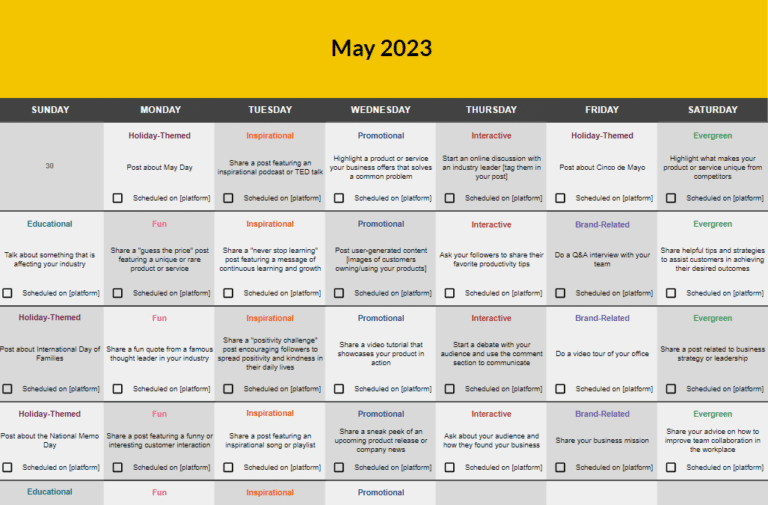
2. Engage with Your Followers
Don’t be afraid to engage with your followers directly on social media. Make it your daily habit to promptly respond to comments and questions from followers. With time, you’ll build relationships with them by showing them that you care deeply about their input.
Make sure that you have a designated person who responds to comments and questions from followers on social media. This member of your team should remain professional at all times and encourage followers to share their views whenever it’s necessary.
3. Share Stories and Testimonials
Real-life stories and testimonials are a great way to engage followers on social media and encourage them to start giving. They also enable people to connect with the stories of the people you helped
Nonprofits should regularly share stories and testimonials on social media. Too much is never enough in this case. This can be easily done with engaging social media content that showcases your day to day processes, the people you’re helping, and the people who contribute with generous donations.
Here are three ways you can use stories and testimonials:
- Highlight testimonials in social media posts – Incorporate quotes from donors and use images of them to emphasize the positive impact the NGO has had on social media.
- Create social media campaigns around testimonials – NGOs can run testimonial campaigns on their social media accounts, such as a “Stories of Impact” campaign, in which beneficiaries, volunteers, and supporters share their stories.
- Encourage user-generated content – Create challenges, utilize hashtags, and offer incentives for supporters to share their experiences with the NGO.
4. Add Donation CTAs
It’s important to keep in mind what will motivate potential donors when writing social media posts to promote donations. The power of a well-written CTA is unbeatable. Therefore, make sure that your copywriter knows what they’re doing.
Here are some effective CTA for raising donations:
- Ask donors to support a specific campaign or goal by explaining the purpose of the campaign, its goals, and how it will make a positive impact.
- Explain how donations will be used by reminding your followers about the people they’ll support and showcasing images and videos to further incentivize them to take a stand.
- Share stories and testimonials about how the organization has helped people in the past, such as Reels of success stories, YouTube testimonials from donors, and images of the people whose lives have been changed for the better accompanied by compelling descriptions that target emotions.
- Offer exclusive donor perks and rewards for contributing, such as giveaways, badges, or exclusive content.
5. Use Branded Hashtags
NGOs should leverage the power of hashtags on social media to boost awareness of their cause and connect with interested donors. Hashtag campaigns are a great way to get your message out there and inform you of how popular your campaign is.
Did you know that using hashtags can increase your Twitter engagement by 100%? That’s yet another reason to give hashtags a try. When used correctly, they can help boost engagement and reach a wider audience.
Here are four tips for using branded hashtags effectively:
- Keep your hashtag short and easy to remember
- Add relevant keywords in your hashtag
- Make sure your hashtag is unique to your organization or campaign
- Promote your hashtag on all of your social platforms
6. Launch a Fundraiser
Nonprofits can use their social media accounts to launch fundraisers in order to increase donations from individuals and organizations.
Spreading the word about a fundraiser through social media and making donations online has never been easier. Additionally, NGOs can utilize social media to create a fundraising campaign that accepts donations over a limited period of time.
Facebook is a social media platform that can be used to launch successful fundraisers for NGOs. Create your very own fundraiser page to promote your cause and ask for donations from individuals or organizations.

However, the success of Facebook fundraisers will rely on how compelling the story about your cause is. This will engage potential donors and offer the reasons why you’re trying to raise funds in the first place.
Here is how you can launch a fundraiser:
- Set a clear goal – Set an achievable fundraising goal and provide updates on progress, such as increasing awareness or acquiring new donors.
- Utilize Facebook Live – Share real-time updates on your fundraiser and the impact of donations with Facebook Live.
- Encourage sharing – Make sure you encourage your friends, followers, and family to spread the word about your fundraiser.
- Follow up with donors – Say thanks to donors and let them know how their donations are making a difference.
Fundraisers on Facebook can be successful for nonprofit organizations if they are well-planned and executed.
7. Share Your Impact
When it comes to social media for nonprofits, another important goal is to share the charity’s impact. Several methods can be used for this, such as sharing success stories, highlighting volunteers, or promoting donations.

Existing and prospective donors wish to see the positive effects of their contributions. Additionally, social media can be used to connect with other charities and form partnerships. This can help further your charity’s reach and impact.
To maximize the impact of nonprofits on social media, you must keep the following, overall goal in mind: always spread the word about the great work you do.
Frequently Asked Questions
1. Which Social Media Platforms Are Best for Nonprofits?
The best social media channels for nonprofits are Instagram, Twitter, LinkedIn, and Facebook. They all offer you the chance to share your work with the world and draw in potential donors who can help advance your cause.
2. Why Is Social Media Useful for Nonprofits?
Social media is important for nonprofits because it can help with raising money, driving more engagement, and nurturing long-lasting relationships with both existing and prospective donors.
3. Is Instagram Good for Nonprofits?
Yes, Instagram is great for nonprofits. The highly visual social channel hosts 50% of NGOs worldwide. It would be a wise decision to join them.
Improve Your Nonprofit’s Social Media Strategy
Social media is a great tool that can be used to reach a large number of people. When used correctly, your chosen platforms can help promote your nonprofit and consequently boost its impact.
Also, socials can be used to connect with other charities and form partnerships. Maximize the existing potential of your nonprofit organization by using the correct social media strategy.
When you manage multiple social accounts, you’ll automatically require a great social media management tool. Busy NGOs must use such tools to optimize their social media efforts and connect with their audience on a daily basis.
Keep in mind that NGOs get a 50% discount for all tool plans! Start your 14-day free trial at SocialBee, your new all-in-one social media management tool, and learn how to do more with less effort!

Do You Run a Nonprofit?
Use code DOGOOD50 at checkout and get a 50% discount on all SocialBee tool plans.
